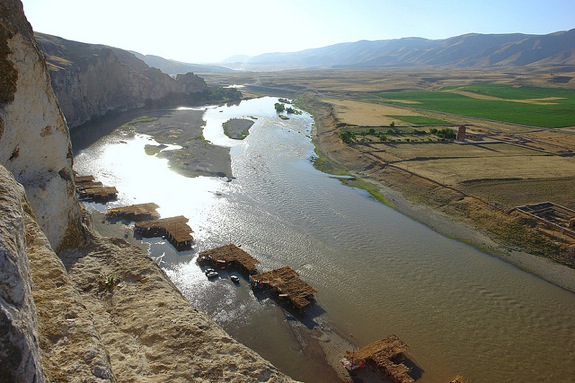Parched Middle East Faces Severe Water Crisis
Drought and over-pumping has led to groundwater losses in the Middle East that equal almost the entire volume of the Dead Sea, a new study shows.
![]()

The Tigris River basin is chief among the regions in the Middle East that have suffered massive groundwater depletion in recent years. Photo by Charles Fred
Climate change, believed to have contributed to the decline of the Ottoman Empire (PDF) when drought forced villagers into a nomadic life in the late 16th century, is once again having an adverse affect on the Middle East. Precipitation has dropped off and temperatures have climbed for the past 40 years, with conditions growing especially severe in the last decade. A 2012 Yale study (PDF) showed that a drought from 2007 to 2010 so seriously stunted agriculture in the Tigris and Euphrates river basins that hundreds of thousands of people fled Iran, eastern Syria and northern Iraq.
A new study published today in the journal Water Resources Research puts an even finer point to the climate change fall-out in the Middle East: The Tigris and Euphrates river basins lost 117 million acre-feet of their stored freshwater from 2003 to 2010, an amount almost equivalent to the entire volume of water in the Dead Sea. The research, conducted by scientists at UC Irvine, NASA’s Goddard Space Flight Center and the National Center for Atmospheric Research, is one of the first large-scale hydrological analyses of the region, encompassing parts of Turkey, Syria, Iraq and Iran.
Drought typically sends water-users underground in search of aquifers, and in the midst of the 2007 water crisis, the Iraqi government, for one, did just that, drilling 1,000 wells. Such pumping has been the primary cause of recent groundwater depletion, according to the new study. Sixty percent of the lost water was removed from underground reservoirs, while dried-up soil, dwindling snowpack and losses in surface water from reservoirs and lakes exacerbated the situation. “The rate was especially striking after the 2007 drought,” hydrologist Jay Famiglietti, principle investigator of the study and a professor at UC Irvine, noted in a statement. Overall, the area has experienced “an alarming rate of decrease in total water storage,” he added.
Since gathering information on the ground in a region marked by such political instability isn’t very practical–or in some cases, even possible at all–the scientists instead utilized data from NASA’s Gravity Recovery and Climate Experiment (GRACE) satellites. These satellites measure a region’s gravitational pull; over time, small changes observed in the strength of this pull are influenced by factors such as rising or falling water reserves. From this, the scientists uncovered variations in water storage over much of the last decade.
The video below is a visualization of groundwater fluctuations in the Tigris and Euphrates basins using GRACE satellite imagery; blues represent wet conditions and reds are indicative of dry conditions. The drought that began in 2007 is clearly reflected.
“The Middle East just does not have that much water to begin with, and it’s a part of the world that will be experiencing less rainfall with climate change,” said Famiglietti. “Those dry areas are getting dryer.” In fact, the region is experiencing the second-fastest rate of groundwater storage loss on the planet, surpassed only by India.
Yet, demand for freshwater continues to rise worldwide, including in the U.S., where aquifer depletion is also a growing problem. Groundwater supplies in the Southwest and western Great Plains have been stressed for many years, according to the United States Geological Survey (USGS). The area surrounding Tucson and Phoenix in south-central Arizona has seen the highest drop in groundwater levels–300 to 500 feet–but other regions have also suffered. Long Island and other parts of the Atlantic coast, west-central Florida and the Gulf Coast region–notably Baton Rouge–are out of balance. And perhaps most surprisingly, the Pacific Northwest is experiencing groundwater depletion as a result of irrigation, industrial water use and public consumption.
According to study co-author Matt Rodell of NASA, such depletion is unsustainable. “Groundwater is like your savings account,” Rodell said. “It’s okay to draw it down when you need it, but if it’s not replenished, eventually it will be gone.”
What’s to be done? More research, according to the authors of the new Middle East study. “The opportunity to construct the most accurate and holistic picture of freshwater availability, for a particular region or across the globe, is now on us,” they wrote. “Such science-informed studies are essential for more effective, sustainable, and in transboundary regions, collaborative water management.” Building on that last point, they called for international water-use treaties and more consistent international water laws.
They will also spread word of their findings by traveling to the Middle East. Famiglietti and three of his UC Irvine colleagues, including the study’s lead author, Katalyn Voss, are heading to Israel, Palestine and Jordan tomorrow to share their data with water authorities, scientists, water managers and NGOs; verify the GRACE measurements with locally obtained data; and begin collaborating with local groups on hydrology and groundwater-availability research.
They hope to educate themselves on the region’s best practices for water efficiency, with the goal of introducing those techniques to other water-strapped areas, including California. “Ideally, this trip will set the foundation for future research collaborations in the region, with universities and government agencies, as well as provide an opportunity for cross-regional learning between California and the Middle East,” Voss told Surprising Science.